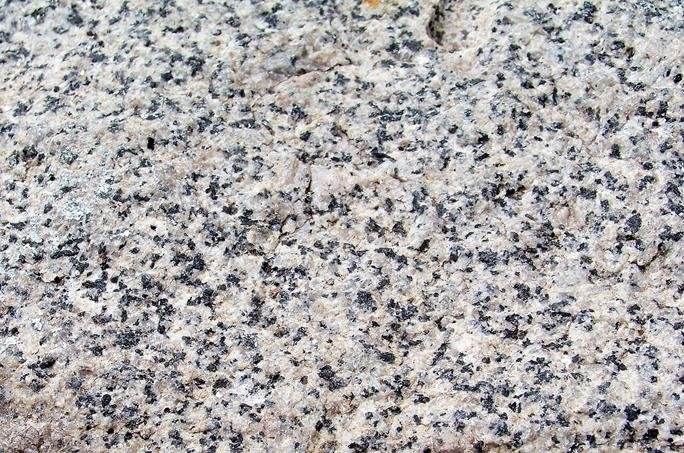Quartz monzonite is a coarse-grained, felsic plutonic, or intrusive igneous rock. Felsic rocks are light-colored rocks rich in lighter elements like silicon, oxygen, aluminum, sodium, and oxygen.
On the other hand, plutonic or intrusive rocks form deep inside the Earth’s crust, where cooling rates are slow. The slow cooling rates favor the formation of a coarse-grained texture characterized by large mineral grains visible with the unaided eye.
Quartz monzonite was once known as adamellite and was named after Monte Adamello, Italy, but this name was later abandoned.
Lastly, quartz monzonite resembles granite. However, it has a slightly lower amount of quartz and silica.

Description and properties
Quartz monzonite is a massive, coarse-grained, light-colored rock with a 2.6-2.8g/cm3 density and a Mohs hardness scale of 6 to 7.
Its color is light gray, with some having pinkish to orange hues. The usual color index, M, is less than 30, and luecoquartz monzonite has a color index of less than 10.
Quartz monzonite is a coarse-grained rock with mostly lighter speckles and a few darker ones. Most of these rocks are porphyritic, with some having perthitic and rapakivi textures.
Porphyritic quartz monzonite rocks have large, well-formed mineral grains or phenocrysts in a finer but coarse-grained or phaneritic matrix or groundmass. These phenocrysts are plagioclase (oligoclase to andesine) and alkali feldspar (mostly orthoclase)
The groundmass will have plagioclase, alkali feldspar minor mafic, and accessory minerals.
On the other hand, perthitic texture forms when sodium plagioclase, usually oligoclase, exsolves in potassium feldspar (orthoclase). Sometimes, the reverse can happen to create an antipathetic texture.
Lastly, in some quartz monzonite, large oval or rounded alkali feldspar phenocrysts are sometimes rimmed by plagioclase, forming a rapakivi texture.
Chemical composition
Quartz diorite is an acidic rock with more than 63 wt.% silica. It is relatively high in alkali oxides (Na2O and K2O) and low in iron and magnesium oxides.
Mineral composition
Quartz is a felsic rock with nearly equal amounts of alkali feldspar and plagioclase, quartz with minor biotite, and sometimes hornblende. Also, it may have pyroxene and rarely olivine.
Accessory minerals may include Fe-Ti oxides (magnetite and ilmenite), zircon, apatite, sphene, allanite, etc.
The plagioclase in this rock is andesine to oligoclase, while alkali feldspar is mostly orthoclase.
On the QAPF classification of igneous rocks, quartz monzonite is a plutonic rock in which quartz is 5-20% of the QAPF content by volume, with plagioclase accounting for 35-65% of the total feldspar.
An increase in quartz to above 20% of the QAPF content by volume grades this rock into granite.
How is quartz monzonite formed?
Quartz monzonite forms from the slow cooling of silica-rich magma deep inside the Earth’s crust. The slow cooling allows large mineral grains to grow, hence the coarse-grained texture.
Magma originates from partially melting subcrustal rocks or fractional crystallization of mantle-derived basaltic magmas. This can happen with or without contamination with subcrustal rock.
Where is it found?
Quartz monzonite occurs mainly on continental volcanic margins where oceanic plate subducts beneath the continental crust and where continental plates collide, including in resultant orogenic belts.
Some places where quart monzonite occurs in the US include Bingham Canyon Mine, Iron Springs mining district, and Little Cottonwood Canyon in Utah.
Also, it occurs in Joshua Tree National Park in California, and Black Canyon of the Gunnison in Colorado. Other locations are Stone Mountain monadnock in Georgia, Idaho batholith’s Atlanta Lobe in Idaho, Puritan (Michigan), and Guilford and Woodstock (Maryland) quartz monzonite.
Elsewhere, it occurs in the D’Aguilar Peninsula in Hong Kong, Terlemez in Turkey, Ronez Quary in the Island of Jersey, Jinling Area in Shandong, China, and Mount Stuart, Castle Hill, and Mount Luisa in Queensland, Australia.
Uses
Quartz monzonite is included in the dimension stone industry, making aggregate with some hosting valuable minerals.
In the dimension industry, these stones are cut and/or polished to make buildings, monuments, curbing stones, tiles, pavers, sculptures, carvings, etc.
This rock has been famous around the Mediterranean Sea since ancient times. It also made the Capital building, a church, and a conference center in Utah.
If crushed, it will aggregate for railroad ballast, fill, subbase, roading industry, and other uses. You can use its gravel on unpaved driveways, pathways, or patios.
Lastly, it is associated with valuable ore minerals like iron, gold, and copper. For instance, copper porphyry deposits at the Bingham Canyon Mine are part quartz monzonite porphyry.
